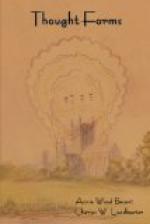HELPFUL THOUGHTS
The Figures numbered 48 to 54 were the results of a systematic attempt to send helpful thought by the friend who has furnished us with the sketches. A definite time was given each day at a fixed hour. The forms were in some cases seen by the transmitter, but in all cases were perceived by the recipient, who immediately sent rough sketches of what was seen by the next post to the transmitter, who has kindly supplied the following notes with regard to them:—
“In the coloured drawings appended the blue features appear to have represented the more devotional element of the thought. The yellow forms accompanied the endeavour to communicate intellectual fortitude, or mental strength and courage. The rosy pink appeared when the thought was blended with affectionate sympathy. If the sender (A.) could formulate his thought deliberately at the appointed time, the receiver (B.) would report seeing a large clear form as in Figs. 48, 49, and 54. The latter persisted for some minutes, constantly streaming its luminous yellow ‘message’ upon B. If, however, A. was of necessity experimenting under difficulty—say walking out of doors—he would occasionally see his ‘forms’ broken up into smaller globes, or shapes, such as 50, 51, 52, and B. would report their receipt so broken up. In this way many details could be checked and compared as from opposite ends of the line, and the nature of the influence communicated offered another means of verification. Upon one occasion A. was disturbed in his endeavour to send a thought of the blue-pink connotation, by a feeling of anxiety that the nature of the pink element should not be misapprehended. The report of B. was that a well-defined globe as in Fig. 54 was first seen, but that this suddenly disappeared, being replaced by a moving procession of little light-green triangles, as in Fig. 53. These few drawings give but a slight idea of the varied flower-like and geometric forms seen, while neither paint nor crayon-work seems capable of representing the glowing beauty of their living colours.”




